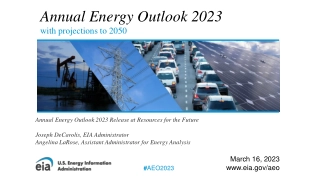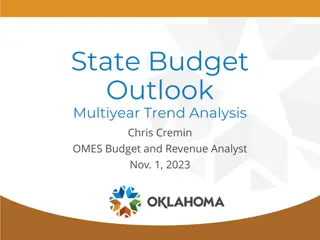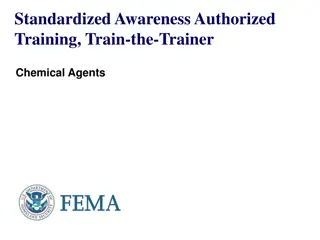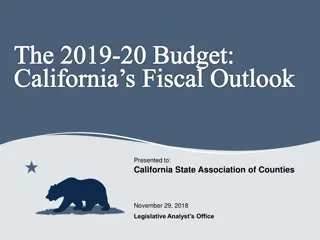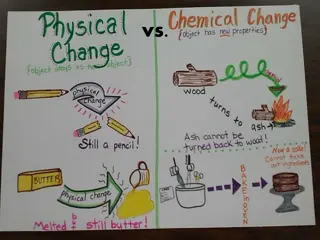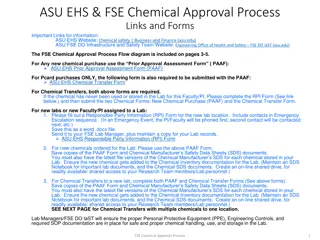
Global Economic Outlook Mid-Year 2021
Explore the mid-year situation and outlook for 2021, highlighting the global macroeconomic trends, the impact of the Covid-19 pandemic, and the recovery projections. Gain insights into the economic indicators, growth prospects, and potential risks shaping the world economy's trajectory.
Uploaded on | 1 Views
Download Presentation

Please find below an Image/Link to download the presentation.
The content on the website is provided AS IS for your information and personal use only. It may not be sold, licensed, or shared on other websites without obtaining consent from the author. If you encounter any issues during the download, it is possible that the publisher has removed the file from their server.
You are allowed to download the files provided on this website for personal or commercial use, subject to the condition that they are used lawfully. All files are the property of their respective owners.
The content on the website is provided AS IS for your information and personal use only. It may not be sold, licensed, or shared on other websites without obtaining consent from the author.
E N D
Presentation Transcript
MID-YEAR SITUATION & OUTLOOK June 2021
Antitrust Reminder We will not be discussing: PRICES, including individual company prices, price changes, price differentials, markups, discounts, allowances, credit terms, etc.; individual company data on costs, production, capacity, inventories, sales, etc.; and industry pricing policies, price levels, price changes, differentials, etc. PRODUCTION, including plans of individual companies concerning the design, production, distribution or marketing of particular products, including proposed territories or customers; and changes in industry production, capacity or inventories. TRANSPORTATION RATES: rates or rate policies for individual shipments, including basing point systems, zone prices, freight equalization, etc. MARKET PROCEDURES, including company bids on contracts for particular products; company procedures for responding to bid invitations; and matters relating to actual or potential individual suppliers or customers that might have the effect of excluding them from any market or influencing the business conduct of firms toward them.
Mid-Year 2021 Situation & Outlook The Covid-19 pandemic resulted in the most severe yet shortest recession since the 1930s, touching virtually every corner of the globe. China was the first affected and first to emerge from the downturn and with extreme fiscal/monetary stimulus, rapid roll-out of vaccinations, and a rapid shift of resources the US economy should fully recover by the end of Q2. In most of the rest of the world, vaccination is key and a resurgence in Covid-19 cases is delaying or slowing recovery as economies struggle to contain outbreaks Recovery will proceed apace despite downside risks Most notable is significant risk of inflation pick-up in United States with more modest threat elsewhere
Global Macroeconomic Outlook Following worst downturn since the Depression, the world economy is rebounding Successful vaccination programs in several countries and some form of reopening has occurred in many places Fiscal stimulus and excess savings fueling demand Global manufacturing and trade has rebounded But Covid cases remain historically high with continued crisis in India, Brazil, and many other nations Growth remains uneven across economies and sectors Inflation is showing up in many places Multiple risks and uncertainties abound We expect global GDP to grow by 6.1% in 2021 and 4.4% in 2022. World trade expands 8.4% in 2021 and 4.8% in 2022. Despite multiple supply chain disruptions, demand for goods is fueling production. Global industrial production is expected to grow by 7.2% in 2021 and 4.6% in 2022. Global Economic Indicators % Change Y/Y 10 8.4 8 7.2 6.1 4.8 6 3.9 4.6 4.4 3.5 4 3.2 3.1 3.1 2.9 2.4 1.0 2 0.9 0 -2 -4 -3.6 -4.2 -6 -8 -10 -8.2 20 18 19 21 22 23 GDP World Trade Industrial Production
U.S. Macroeconomic Outlook U.S. Economic Indicators The economic recovery in the U.S. accelerated during Q1. Federal stimulus, vaccinations, and resilient demand are fueling the recovery across multiple segments. Expectations continue to improve. Following a 3.5% decline in 2020, U.S. GDP is expected to rebound in 2021, up by 6.4% and continue to grow by 4.3% in 2022. Accounting for about 70% of the U.S. economy, consumer spending is expected to rise 7.6% in 2021 and 4.3% in 2022. Business investment declined 5.2% in 2020 with expected growth of 8.2% in 2021 then 6.2% growth in 2022. Job market improving, but slack remains especially in certain industry segments. Unemployment rate expected to continue to ease, averaging 5.4% in 2021 and 4.2% in 2022. % Change Y/Y 10 8.2 7.6 8 6.4 6.4 6.2 6 4.3 4.3 4 3 2.9 2.9 2.6 2.6 2.3 2.1 1.9 2 0 -2 -4 -3.5 -3.9 -5.2 -6 18 19 20 21 22 23 GDP Consumer Spending Business Investment
Outlook for End-Use Sectors Housing Starts (million) Vehicle Sales (million) Vehicle sales fell to 14.4 million in 2020, but despite key material shortages creating production constraints, sales are expected to average 17.0 million in both 2021 and 2022. 17.5 1.65 17.2 17.0 17.0 17.2 1.60 17 16.9 1.55 1.56 1.59 16.5 Record-low mortgage rates and remote work resulted in surging demand for housing in 2020 that has persisted into 2021. Housing starts climbed to 1.4 million in 2020 and are expected to rise to 1.59 million in 2021 (highest level since the start of the housing crisis) and ease slightly to 1.56 million in 2022. 1.50 16 1.45 1.40 15.5 1.40 1.35 1.34 15 1.30 1.3 14.5 1.25 1.25 14.4 14 1.20 18 19 20 21 22 23 Vehicle Sales Housing Starts
Outlook for U.S. End-Use Industries 2018 4.3 2019 -2.4 2020 -24.3 2021 19.7 2022 5.2 2023 3.7 Motor Vehicles & Parts Aircraft & Parts Appliances Iron & Steel Petroleum Refining Rubber & Plastic Products Semiconductors & Electronics Furniture Fabricated Metal Products Computers Construction Paper Structural Panels Food, Beverages & Tobacco Apparel Textile Mill Products Oil & Gas Extraction Printing As consumer spending shifted from services to goods, manufacturing rebounded quickly after lockdowns ended. Industrial activity started rebounding in Q3 2020 and has been accelerating. Supply chain disruptions from weather, logistics, etc. have provided headwinds in several industries, however. In 2021, industrial production is set to rebound by 5.5% before growing by 4.3% in 2022 Most industries will grow in 2021 with the fastest growth in durable goods manufacturing -1.7 2.3 -19.2 12.2 5.4 4.0 -0.6 -3.5 1.9 9.4 1.8 2.2 6.0 0.2 -15.6 8.4 3.4 1.5 1.7 -1.8 -15.9 7.5 1.4 0.4 1.9 -1.7 -7.8 7.0 3.6 3.0 9.1 4.2 5.8 5.9 5.4 3.4 -0.1 -0.2 -9.9 5.0 1.8 2.2 5.0 1.1 -7.5 4.9 1.6 1.6 5.3 5.2 1.9 4.7 2.9 2.5 3.1 1.4 -3.1 4.2 1.7 1.5 -1.1 -3.1 -2.1 3.9 0.9 0.6 3.1 -1.0 -1.2 3.6 1.1 1.5 1.9 0.0 -1.6 2.7 1.5 1.6 -3.5 -12.2 -14.6 2.3 -1.4 -1.4 -0.9 -7.9 -10.8 2.2 -1.7 -1.5 16.8 10.8 -3.4 -2.2 1.4 0.7 -2.5 -4.0 -10.9 -2.3 -0.3 -0.4
Natural Gas Based Petrochemicals Remain Competitive Naphtha is a petroleum product whose price is closely tied to oil. Ethane is a natural gas liquid (NGL) co-produced with natural gas production. Its price is correlated with natural gas prices. Because competing producers in Europe and Asia generally use naphtha feedstocks and North American producers generally use ethane and other NGL feedstocks, we look to the relative price of oil to natural gas as a proxy measure for U.S.-based petrochemicals competitiveness. As a rough rule-of-thumb, when the oil-to- natural gas price ratio is above 7, U.S. petrochemicals are relatively advantaged. When the ratio is below 7, U.S. petrochemicals are less advantaged. Oil-to-Natural Gas Price Ratio 45 40 35 30 More competitive 25 20 Less competitive 15 10 5 0 94 96 98 00 02 04 06 08 10 12 14 16 18 20 22 24 Sources: EIA, NYMEX, ICE, Oxford Economics
U.S. Chemistry Rebounds from Pandemic Recession Chemicals (exc. pharm) Specialties Consumer Products Basic Chemicals Agricultural Chemicals % change 8 6 4 2 0 -2 -4 -6 -8 -10 -12 2018 2019 2020 2021 2022 2023 2024 2025
U.S. Basic Industrial Chemical and Synthetic Materials Production Outlook by Segment Production Index (2012=100) Synthetic Materials 130 Year 2018 Total Inorganics Organics 3.5 120 1.6 3.8 -0.2 110 2019 -0.4 1.9 -1.5 -3.7 100 2020 -1.3 -1.9 -0.9 -17.8 90 2021 0.5 1.6 0.0 0.1 80 2022 3.4 2.1 4.0 3.5 70 2023 2.1 1.0 2.4 2.4 Total Inorganic Organic Synthetic Materials Sources: ACC
U.S. Specialty Chemicals As end use markets collapsed due to the pandemic, specialty chemical production was off 10.8% in 2020. % change Y/Y 15 Rebounding growth in 2021 was tempered by winter storms and material shortages during H1. 10.4 10 6.9 5 3.84.1 4.0 3.7 3.2 2.5 1.7 0.4 For 2021, coatings expected to be up by 2.5% before growing 5.5% in 2022. 0 -0.4 -0.8-1.6 -1.9 -2.7 -5 -3.4 Other specialty chemicals expected to grow by 4.3% in 2021 before growing by 3.5% in 2022. -10 -8.7 -10.8 -15 -14.2 -20 05 07 09 11 13 15 17 19 21 23 Sources: ACC
Outlook for U.S. Chemistry As key end-use markets and export customers for U.S. chemistry recover, U.S. chemistry volumes are expected to expand as well. The oil-to-natural gas price ratio is balanced. The U.S. will remain a competitive location for petrochemical manufacturing. As a result, chemical volumes are expected recover 1.4% in 2021 before rising by 3.2% in 2022. Basic chemicals: 0.5% in 2021, 3.4% in 2022 Specialty chemicals: 3.8% in 2020, 4.1% in 2022 Shipments are expected to rise 8.1% in 2021 to $526 billion and by 8.2% in 2022 to $569 billion. After falling by 14,800 (2.7%) in 2020, employment is expected to recover by 6,000 (1.1%) in 2021 and by 1.3% in 2022. After falling 17.6% in 2020, capital spending rebounds 11.9% to $30.6 billion in 2021, but slows to a 3.1% gain in 2022. U.S. Chemical Volumes % Change Y/Y 20 14.2 15 12.3 10.6 10 6.2 4.8 4.1 4 4.0 5 3.8 3.5 3.1 2.6 0.6 1.4 0.6 0 -5 -10 -8.9 -9.3 -15 -13.6 20 17 18 19 21 22 Total Chemicals Basic Chemicals Specialties
U.S. Chemicals Outlook: By Segment % change Y/Y While demand for some chemical products rose significantly in 2020 as part of the response to Covid-19, most demand channels for chemistry products weakened substantially in 2020. As a result, total chemical production is expected to fall by 9.3% in 2020 before rebounding by 12.3% in 2021. 25 20 15 10 5 Production of basic chemicals, which eased in 2019, is expected to fall 8.9% in 2020 before rising by 14.2% in 2021. Specialty chemicals are expected to weaken further, down 13.6% in 2020 before recovering by 10.6% next year. Production of agricultural chemicals will fall 9.3% before improving by a similar amount the following year. Bolstered by sales of cleaning and disinfecting products, consumer products production is expected to fall by only 6.8% this year and grow by 9.3% in 2021. 0 -5 -10 -15 -20 17 18 19 20 21 22 23 24 25 Total Chemicals (ex. pharma) Consumer Products Specialties Agricultural Chemicals Basic Chemicals
U.S. Basic Chemicals Outlook: By Segment % change Y/Y With demand destruction along key supply chains, basic chemicals production is expected to fall 8.9% in 2020, before rebounding by 14.2% in 2021. 20 15 10 Bulk petrochemicals and organic chemicals are expected to decline by 9.3% before rebounding by 15.2% in 2021. Inorganic chemicals are expected to fall 11.0% this year before recovering to a 15.2% pace in 2021. 5 0 -5 Of the major basic chemical segments, plastic resins fares the best with an expected decline of only 5.6% in 2020. This reflects offsetting demand for plastics used in PPE, barriers, medical supplies, and packaging. Plastic resins are expected to grow by 13.1% in 2021 and grow throughout the forecast period. Synthetic rubber is expected to decline 14.3% this year and grow by 8.9% in 2021. Manufactured fiber production is expected to decline 12.6% before growing by a modest 3.6% in 2021. -10 -15 -20 17 18 19 20 21 22 23 24 25 Inorganics Plastic Resins Manufactured Fibers Bulk Petrochemicals & Organics Synthetic Rubber
U.S. Chemical Industry Outlook: Shipments $ Billions % Chemical industry shipments are expected to fall 13.5% in 2020 to $488.6 billion. Industry shipments begin to recover in 2021, but are not expected to reach pre-Covid levels until 2022. After 2020, shipments are expected to increase on average by 6.5% per year through 2025. By 2025, chemical industry shipments are expected to reach $668 billion. $800 25 20 $700 15 $600 10 $500 5 $400 0 -5 $300 -10 $200 -15 $100 -20 $0 -25 08 09 10 11 12 13 14 15 16 17 18 19 20 21 22 23 24 25 Shipments (left) % Change (right) Source: ACC Mid-Year 2020 Situation & Outlook
U.S. Chemical Industry Outlook: Employment $ Thousands % Following a steep contraction in 2020, chemical industry employment is set to grow by nearly 6,000 to 535,000 in 2021. As demand firms in 2021 and 2022, employment recovers, but with productivity gains does not recover to its pre-Covid level until 2023. The chemical industry remains a major U.S. employer, paying its workers on average more than $90,000 in 2020. These jobs and the wages they pay support local communities around the country. $560 2 1 $550 0 $540 -1 $530 -2 $520 -3 $510 -4 $500 -5 $490 -6 $480 -7 08 09 10 11 12 13 14 15 16 17 18 19 20 21 22 23 24 25 Employment (left) % Change (right) Source: ACC Mid-Year 2021 Situation & Outlook
U.S. Chemical Industry Capital Spending Outlook $ Billions % Change 37 $40 40 33.1 $35 30 $30 20 14.1 11.9 $25 8.6 8.2 10 3.9 3.3 3.1 2.3 1.7 $20 0 $15 -1 -1.1 -1.6 -3.9 -10 $10 -10.5 -20 $5 -17.6 -19.4 $0 -30 08 09 10 11 12 13 14 15 16 17 18 19 20 21 22 23 24 25 % Change (right) Capital Spending (left) Source: ACC Mid-Year 2021 Situation & Outlook
U.S. Chemical Industry Capital Spending by Asset Class, 2021 2021 Capital Spending: $30.61 billion (up 11.9%) Other Machinery & Equipment 6% Other -2% Computer & Communications Equipment 5% Pressure Vessels & Other Fabricated Equipment 5% General Industrial Equipment 41% Special Industrial Machinery 18% Other includes furniture, electric transmission & distribution, motor vehicles, other transportation equipment, office buildings and other structures Manufacturing Structures 9% Instrumentation 14% Source: ACC Mid-Year 2021 Situation & Outlook
U.S. Chemical Industry Capital Spending Outlook by Segment $ Billions $40 $35 $30 $25 $20 $15 $10 $5 $0 2008 2009 2010 2011 2012 2013 2014 2015 2016 2017 2018 2019 2020 2021 2022 2023 2024 2025 Agricultural Chemicals Inorganic Chemicals Plastic Resins Consumer Products Bulk Petrochemicals & Intermediates Synthetic Rubber Source: ACC Mid-Year 2021 Situation & Outlook
U.S. Chemical Industry Capital Spending by Segment, 2021 2021 Capital Spending: $30.61 billion (up 11.9%) Agricultural Chemicals 4% Manufactured Fibers 1% Coatings 2% Other Specialties 7% Synthetic Rubber 4% Consumer Products 15% Inorganic Chemicals 10% Other includes furniture, electric transmission & distribution, motor vehicles, other transportation equipment, office buildings and other structures Plastic Resins 30% Bulk Petrochemicals & Intermediates 27% Source: ACC Mid-Year 2021 Situation & Outlook
U.S. Chemical Industry Capital Spending Outlook by Asset Type $ Billions $40 $35 $30 $25 $20 $15 $10 $5 $0 2008 2009 2010 2011 2012 2013 2014 2015 2016 2017 2018 2019 2020 2021 2022 2023 2024 2025 General Industrial Equipment Instrumentation Pressure Vessels & Other Fabricated Equipment Other Machinery & Equipment Manufacturing Structures Special Industrial Machinery Computer & Communications Equipment Other Source: ACC Mid-Year 2021 Situation & Outlook
U.S. Chemicals Trade Exports, Imports $ Billions Net Exports $ Billions After falling sharply last year, US chemical exports are expanding this year as import demand in partner economies improves as major economies reopen. The recovery will be mixed and is still vulnerable to risks. After falling 7.6% in 2020, US chemical exports will rise 5.8% in 2021 and accelerate to 13.8% gain in 2022, when recovery to pre-Covid levels is expected. $160 $80 $140 $70 $120 $60 $100 $50 $80 $40 $60 $30 After falling 5.1% in 2020, US chemical imports will rise 1.6% in 2021. Imports will further recover in 2022, growing 13.7%. Again, recovery to pre- Covid levels is not expected. $40 $20 $20 $10 US chemical shipments to Canada, Mexico, Europe and all other destinations will recover. Trade in chemicals used as inputs into the automotive supply chain and other sectors will also improve. $0 $0 2005 2010 2015 2020 2025 Net Exports Exports Imports The US chemical industry will maintain its net exporter position, supporting total US goods exports. By 2025, net exports of chemicals will reach $40.5 billion. Source: ACC Mid-Year 2021 Situation & Outlook
Risks to Consider Vaccine distribution & efficacy issues, resurgence of pandemic (with new strain), or new virus Supply chain constraints along with increased demand as economies reopen, and loose monetary policy result in systemic inflation Trade tensions Weather events, cybersecurity and similar shocks Financial volatility Credit cycle turn with pressure on riskier financial assets (high-yield corporate debt, etc.) Public sector debt in advanced nations and private sector debt everywhere Fed and other central bank policy errors Geopolitical risks (South China Sea, Baltics/Other Eastern Europe, Middle East, Korea, etc.) That said, there are many risks to the upside risks
For Further Information Please feel free to address questions to: Dr. Thomas Kevin Swift Chief Economist & Managing Director Email: kevin_swift@americanchemistry.com Follow me on Twitter @DrTKSwift Martha Gilchrist Moore Senior Director, Policy Analysis and Economics Email: martha_moore@americanchemistry.com
U.S. and Global Macro Expectations % per year (unless otherwise noted) U.S. 2015 2016 2017 2018 2019 2020 2021 2022 2023 2024 2025 GDP Consumer Spending Business Investment Industrial Production Light Vehicle Sales (mm) Housing Starts (mm) Consumer Prices 10-Year Treasury Notes (%) Unemployment Rate (%) Exchange Rate ($US/euro) 1.6 2.7 0.7 -2.0 17.5 1.18 1.3 1.84 4.9 1.11 2.4 2.6 4.4 2.3 17.1 1.21 2.1 2.33 4.4 1.13 2.4 2.6 4.4 2.3 17.1 1.21 2.1 2.33 4.4 1.13 2.9 3.0 6.4 4.0 17.2 1.25 2.4 2.91 3.9 1.18 2.3 2.6 2.1 0.9 16.9 1.30 1.8 2.14 3.7 1.12 -3.5 -3.9 -5.2 -6.7 14.4 1.40 1.2 0.89 8.1 1.14 6.4 7.6 8.2 5.5 17.0 1.59 2.8 1.80 5.4 1.20 4.3 4.3 6.2 4.3 17.0 1.56 2.3 2.09 4.2 1.23 1.9 2.6 2.9 2.3 17.2 1.34 2.1 2.18 4.1 1.22 1.6 2.4 2.5 1.8 17.2 1.33 2.1 2.32 4.2 1.23 1.7 2.1 2.7 1.5 17.1 1.38 2.1 2.41 4.1 1.24 Global Macro GDP World Trade Industrial Production 2.6 2.3 1.9 3.2 5.7 3.5 3.2 5.7 3.5 3.1 3.6 3.1 2.4 1.0 0.9 -3.6 -8.2 -4.2 6.1 8.4 7.2 4.4 4.8 4.6 3.2 3.9 2.9 2.9 3.8 2.4 2.9 3.8 2.2
U.S. End-Use Industries % per year (unless otherwise noted) 2015 2016 2017 2018 2019 2020 2021 2022 2023 2024 2025 Construction Oil & Gas Extraction Food, Beverages & Tobacco Textile Mill Products Apparel Structural Panels Paper Printing Petroleum Refining Rubber & Plastic Products Iron & Steel Fabricated Metal Products Computers Semiconductors & Electronics Appliances Motor Vehicles & Parts Aircraft & Parts Furniture 0.7 6.7 2.1 -2.8 -5.0 3.1 -0.7 -1.0 -2.3 0.9 -9.6 -3.3 0.6 0.3 6.5 5.3 0.1 4.9 0.9 -4.0 1.2 -0.5 -6.1 3.5 -0.9 1.7 7.7 -0.6 -4.6 -3.7 2.1 8.2 3.9 1.3 -6.9 0.3 3.2 3.6 2.5 2.2 -9.8 4.4 -0.6 0.8 -0.3 -1.0 4.4 1.1 4.0 1.6 0.8 -0.2 0.3 -0.2 3.1 16.8 1.9 -0.9 -3.5 3.1 -1.1 -2.5 1.7 1.9 6.0 5.0 5.3 9.1 -0.6 4.3 -1.7 -0.1 1.4 10.8 0.0 -7.9 -12.2 -1.0 -3.1 -4.0 -1.8 -1.7 0.2 1.1 5.2 4.2 -3.5 -2.4 2.3 -0.2 -4.0 -4.5 -0.3 -10.1 -4.5 -2.3 -3.1 -12.3 -14.7 -6.6 -16.8 -7.5 2.9 7.7 2.9 -15.1 -19.4 -10.2 4.1 -4.1 2.7 3.4 2.5 4.7 3.8 -0.5 4.2 6.9 9.0 7.0 6.7 10.1 12.1 17.8 11.3 4.0 2.1 1.3 1.5 -1.1 -0.3 0.8 0.2 0.2 1.1 2.4 0.4 1.6 2.5 4.9 1.0 3.6 5.5 2.1 1.4 1.0 1.6 -1.7 -0.9 0.8 0.1 -0.9 -0.2 2.4 1.0 1.3 2.4 3.7 1.9 3.1 3.7 1.7 2.0 0.4 1.8 -2.0 -2.2 1.4 0.4 -0.4 1.4 2.5 2.1 1.1 2.6 4.2 1.9 1.2 3.7 2.2 2.0 0.1 1.7 -2.0 -2.7 1.5 0.9 -0.2 1.5 2.1 2.5 1.6 2.9 4.4 1.8 1.1 3.5 2.4
U.S. Chemical Industry Expectations: Production Volumes % per year (unless otherwise noted) 2015 2016 2017 2018 2019 2020 2021 2022 2023 2024 2025 Production Volumes Total Chemicals (ex. pharma) Agricultural Chemicals Fertilizers Crop Protection Consumer Products Basic Chemicals Inorganics Bulk Petrochemicals & Organics Plastic Resins Synthetic Rubber Manufactured Fibers Specialties Coatings Other Specialties -3.0 -12.6 -16.6 -5.8 0.1 -3.3 -2.8 -2.8 -4.9 -1.3 -5.7 -0.8 2.1 -2.4 0.1 2.1 1.2 3.6 -3.0 1.7 -0.3 2.9 1.1 -1.2 -4.3 -1.6 1.1 -3.1 3.8 21.7 28.4 12.8 2.2 1.4 -2.5 3.0 0.5 1.9 1.2 6.9 12.0 3.9 4.1 4.5 7.3 0.5 5.6 3.5 1.6 3.8 5.2 -0.5 -0.6 4.0 3.5 4.4 -0.1 -0.5 0.0 -1.4 -1.5 -0.4 1.9 -1.5 1.2 -4.3 -2.5 2.5 -0.3 4.3 -3.6 -3.9 -0.4 -6.5 -3.6 -1.3 -1.9 -0.9 0.9 -18.9 -11.7 -10.8 -13.9 -9.5 1.4 1.3 1.6 1.0 2.3 0.5 1.6 0.0 -0.5 5.8 1.5 3.8 2.5 4.3 3.2 2.1 2.9 1.5 2.5 3.4 2.1 4.0 4.1 1.5 -1.5 4.1 5.5 3.5 1.7 0.6 1.2 0.2 0.9 2.1 1.0 2.4 3.0 0.0 -2.0 1.7 1.9 1.5 1.9 1.1 1.7 0.7 1.5 2.1 1.2 2.5 2.9 0.0 -2.0 1.7 1.7 1.6 1.9 1.2 1.7 0.7 1.6 2.1 1.2 2.5 2.8 0.1 -2.0 1.6 1.8 1.6
U.S. Chemical Industry Expectations: Other Indicators % per year (unless otherwise noted) 2015 2016 2017 2018 2019 2020 2021 2022 2023 2024 2025 Total Shipments ($ billions) % Change $521.6 $503.4 $523.1 $548.8 $509.4 $486.0 $525.6 $568.7 $600.1 $629.0 $658.6 -6.4 -1.9 5.8 6.1 0.5 -13.5 8.1 8.2 5.5 4.8 4.7 Employment (thousands) % Change 525.5 0.3 525.8 0.1 531.3 1.0 538.4 1.3 543.8 1.0 529.0 -2.7 535.0 1.1 542.0 1.3 544.0 0.4 545.0 0.2 546.0 0.2 Capital Spending ($ billions) % Change $31.0 14.1 $31.5 1.7 $31.2 -1.1 $30.7 -1.6 $33.2 8.2 $27.3 -17.6 $30.6 11.9 $31.6 3.1 $32.3 2.3 $33.3 3.3 $34.6 3.9
U.S. Chemical Industry Expectations: Trade Billions of Dollars 2015 2016 2017 2018 2019 2020 2021 2022 2023 2024 2025 Exports Imports Total Trade Trade Balance $128.3 $121.0 $130.1 $140.1 $135.5 $125.2 $132.5 $150.8 $162.5 $172.3 $181.5 $95.2 $93.1 $97.1 $109.0 $101.9 $96.7 $223.5 $214.1 $227.2 $249.0 $237.4 $221.9 $230.8 $262.5 $285.3 $303.8 $322.5 $33.1 $27.9 $33.1 $31.1 $33.7 $28.6 $98.3 $111.8 $122.8 $131.5 $141.0 $34.3 $39.0 $39.8 $40.8 $40.5

